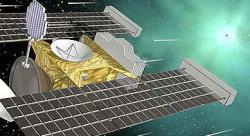°•. Advances
Because
of Aerogels many special properties that can be manipulated by altering
different traits of Aerogel's chemistry Aerogel has had many practical
uses for todays world. Since its discovery in 1931 Aerogel has come a
long way and is now used in some of todays most advanced fields and has
went hand in hand with todays modern technology. Aerogel has began
being used on a wider basis because the costs in creating it have been
greatly reduced and with todays technology we have been able to
manipulate Aerogels in ways that were thought to be impossible
before.
°•. Practical Uses of
Today...
- Aerogel is considered
the strongest lightest, and only transparent building material is is
being used for modern housing and construction
- Used for
super-insulating skylights, solar collector covers, and specialty
windows
- The "Utlimate sponge"
because of its millions of pores it has the ability to absorbe
pollutants in water with recent versions of it being used to soak up
lead and mercury from water. Another version known as Nanogel has been
chemically altered to soak up oil, and has been shown to be more
effective that other current materials normally used for oil.
- Its Insulation
properties have been used for house insulation and creating super warm
blankets.
- Aerogel is beginning to
be used in protection in motor vehicles, protection of sensitive
equipment such as aircraft flight data recorders, and protection of
electronic equipment such as laptop computer hard drives
- Aerogel is also being
looked at for uses in tennis rackets.
- Military is looking
into Aerogel for bombproof housing, and armoured Military vehicles
after laboratory tests resulted in a metal plate coated in 6mm of
aerogel was left almost unscathed by a direct dynamite blast.
- Boots for moutain
climbers that Aerogel insoles are being made for extreme weather
conditions.
- Researchers believe
that some versions of aerogel which are made from platinum can be used
to speed up the production of hydrogen. As a result, aerogel can be
used to make hydrogen-based fuels
- Used as a thickening
agent in napalm bombs
- Used as a
paint thickening agent

°•. NASA
and Aerogel
In the late 1980's Dr. Peter Tsou
at NASA’s Jet Propulsion got NASA involved with Aerogel. Tsou
determined that Aerogel could be used in space exploration for
capturing stardust on probs. In project "Stardust" which was
launched in 1999 in an expedition to explore the Comet Wild 2. It
intercepted the comet in 2004 and returned to Earth in January 2006.
The space craft had a large array of holding cells which contained
Aerogel that caputured many microscopic comet dust particles. In 2002
Aspen Aerogel, a company created by Nasa, produced a stronger and more
flexible version of Aerogel which they are using to develop an
insulated lining in space suits for the first manned mission to Mars,
scheduled for 2018. Mark Krajewski, a senior scientist at the company,
believes that as little as a 18mm layer of Aerogel would protect
austronauts from temperatures as low as -130°C.
